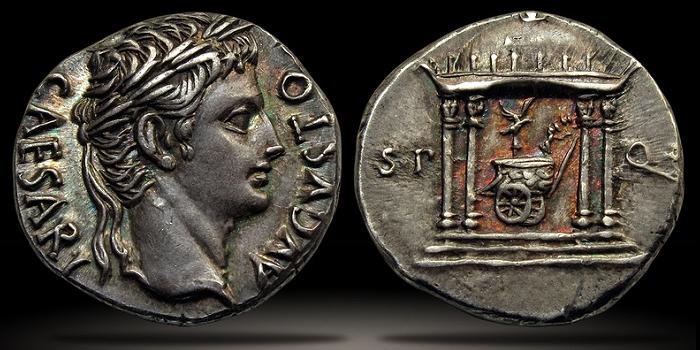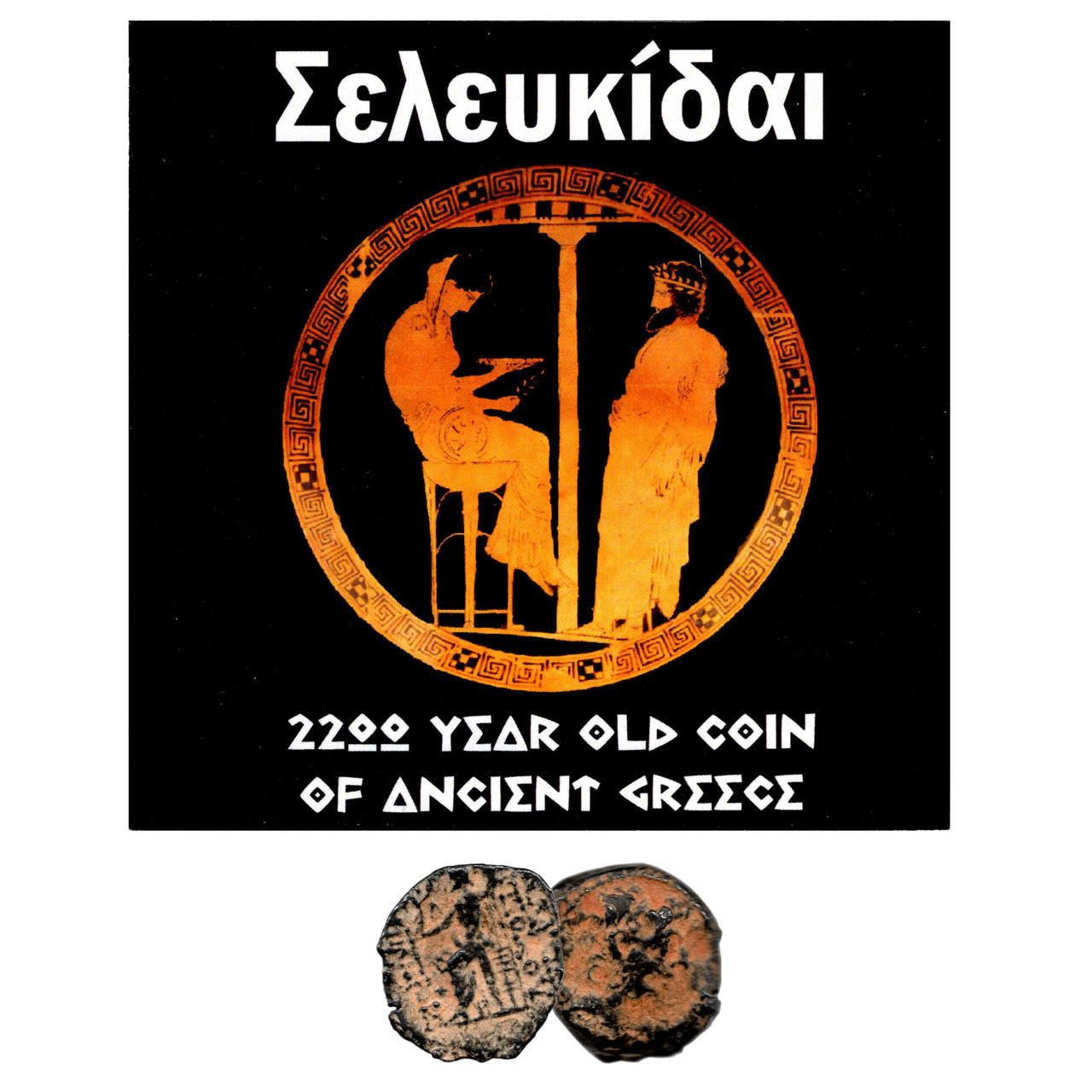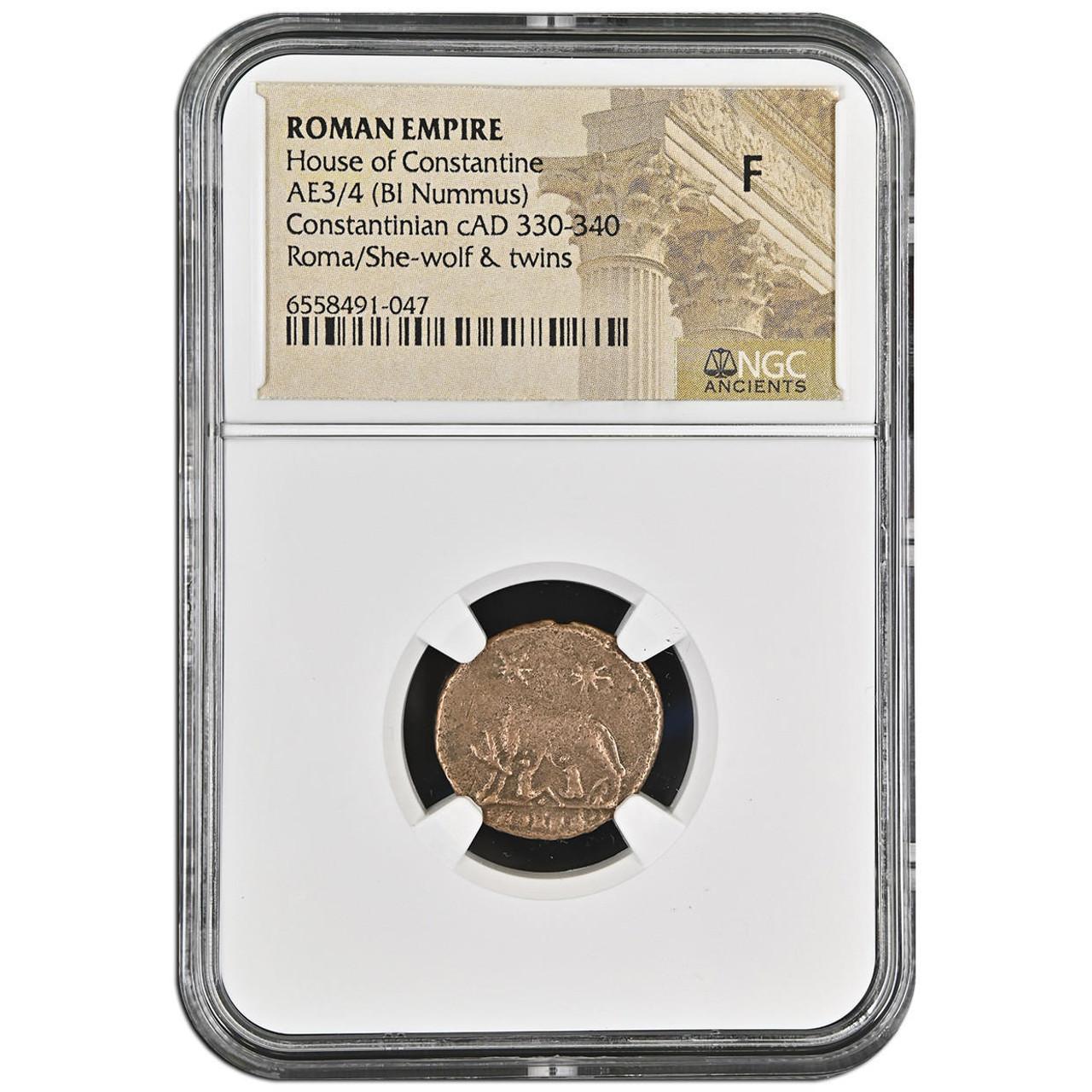The Most Popular Greek and Ancient Roman Coins: A Guide
Posted by Andrew Adamo on Sep 23rd 2024
Collecting Greek and Roman Coins
What's the oldest object that most people have held in their hands? For some, it might be an arrowhead dug up in the backyard during childhood. Others may have had to don white gloves and visit an archive to feel history beneath their fingers. For the collectors of ancient Greek and Roman coins, history is everywhere, and anyone can become involved in this enthralling hobby!

The period of history that we call antiquity spanned about twenty-one centuries - that's well over 2,000 years! That's 2,000 years' worth of ancient coins for collectors to track down and amass! Compare that to our own United States Mint, which has only been minting coins for about 200 years!
Where exactly did the practice of collecting these relics begin, and how can an intrigued collector get involved? This article will describe the history of currency and trade in the ancient world, as well as the many precious coins that are out there for collectors to scoop up and treasure! Keep reading to learn about how you can get involved in tracking down these rare and fascinating artifacts of the ancient world!
Where Did Ancient Currency Begin?
Holding a 2,000-year-old coin in your hand might feel mindblowing, but put into context, an Ancient Greek coin is comparatively shiny and new! Man has been using physical currency for close to 40,000 years! Needless to say, it took some time for coins to evolve into the pieces of collectible art they became during the height of the Ancient Roman republic.
Humans have been marking exchange as a measure of value since the paleolithic times. The first coins likely weren't coins at all, but natural objects that took on value in a given society or culture. For example, archeologists have unearthed 3,000-year-old cowry shells in China used as a unit of account.
Archeologists found the first coin mints in Asia Minor, which were likely the early precursors to Ancient Greek coins. Most historians believe that the shift to coinage occurred as the discovery of precious metals boomed. Government minting allowed early political leaders to maintain control over commerce in a given society.
Coins were also easy to carry and transport when compared to cumbersome alternatives like cattle trade. A poorly timed bovine virus was unlikely to take down the entire system of minted currency. Thus, coins became a positive societal force that helped raise armies, encouraged exchanging goods non-violently, and fostered relationships between disparate cultural groups.
Early Roman Coins
When people think of Ancient Rome, their minds often conjure Caesar, Brutus, and the Roman Empire. The first formal currency appeared during Rome's republican years. There is evidence that the Romans relied on a series of bronze weights called the aes rude through about 218 B.C.E.
While still easier to carry than an entire cow, these early symbols of trade were heavy. They weighed about 11.5 ounces individually!
Once the Romans found success on the battlefield, they gained access to more natural resources. This included the precious metals that they found throughout the Mediterranean and North African regions.
The first Roman coins were simple and bronze, produced around 326 B.C.E. Silver coins would shortly follow. By the early third century, the Greek influence became clear, as these silver coins closely resembled Greek coinage from the same period.
As it turns out, war and conquest are expensive undertakings. The Punic Wars led the Romans into a period of austerity reflected in their minting. Coins became smaller and lighter in weight, with less metal content.
Desperation even led the Romans to produce a rare find for collectors - the Roman aurei, minted from pure gold. Rome would not utilize gold for coins again until the first-century B.C.E.
Middle Roman Coins
Around 211 B.C.E., the system of Roman currency underwent a major transformation. Many of these changes would last until the 3rd century AD when Rome had transitioned to an imperial system.
The first big shift was the creation of a silver coin called the denarius. It was primarily funded through the acquisition of war booty as Rome found victory over Carthage. The weight of the coins still played a role years after the early Roman aes rude became obsolete. The denarii were principal coins, so the Romans minted other coins in proportion to their weight.
Lower value coins included the bronze asses. Ten as equaled one denarius.
A silver coin, the victoriatus, was worth three-quarters of the denarius. The quinarii was worth half of the denarius. They minted other coins, but they were uncommon and less consistently found throughout the late republic and early empire.
At this moment in history, Roman coins were now produced exclusively in Italy. Circulation spread as conquest increased. Coins from this period no longer had markings indicating a country of origin as a result.
Silver began to replace bronze as the primary metal used for minting in the empire. This was most likely due to Rome's acquisition of the Macedonian silver mines. The bronze asses decreased further in value as a result.
By 84 BCE, gold coins would appear in circulation once again, too. They were specifically minted to pay the armies. Julius Caesar was responsible for minting the larger number of golden coins in Roman history.
Late Roman Coins
Caesar was the first to mint coins featuring his visage, but other Roman leaders quickly followed suit. Famously, Brutus minted a coin to replace those featuring Caesars. His coins featured his portrait on one side, and crossed daggers on the other!
Emporer Augustus did more than simply mint a coin featuring his portrait, however. He reformed the entire system of currency once again. His changes would persist for three centuries!
Augustus began minting brass and copper coins to replace the lower denomination bronze coins of the past. The denarius would persist, however, as would the golden aureus.
As the empire spread, more mints went into production. While many regional variations began to appear, they were all convertible to the values of Roman coins.
Variations in imperial Roman coins were often due to the extravagant tastes of the emperors. Putting more coins into circulation was costly, but everyone wanted their face on the currency! Thus, they minted more coins, but many became lighter and contained less metal content.
At one point, archeologists believe the Romans were minting coins with a mere 2% of silver content! The value of the metal was no longer equal to the value of the coin. Many clever Romans chose to pay their taxes using the less valuable new coins, keeping the precious metals for themselves!
You will find some later coins stamped to indicate their metal content.
Collecting Ancient Roman Coins
Given all of the history involved, one might think that the only place to find these coins would be a museum. The truth is, there are many ways to get involved with collecting old Roman coins. Many sets are affordable enough for casual hobbyists looking to start a new collection!
Many people claim that collecting Roman coins is one of the most satisfying pastimes for new collectors. There are so many sets and variations that collectors can find themselves on the hunt for years - even decades. All a new collector needs to do is pick a place to start!
One way to begin a collection is to decide exactly how you'd like to organize your coins. We suggest three ways to begin with Roman coins: by Typeset, by emperor, or by theme.
Roman Coins by Typeset
When collecting Roman coins by typeset, you will find yourself collecting coins of a certain type or denomination. They will either share a name, a value, or a type of metal.
For example, you might choose to collect a bronze Roman coin, such as the as. You might include early versions of the coin through more modern iterations. You can organize these coins as a timeline, ending with the copper version of the as struck by Augustus.
You might also choose to collect versions of the Roman denarius, a Roman silver coin that went through many changes since it first appeared. Your collection will likely begin with heavy, solid silver coins that grow lighter over time. Late versions of the denarius had serrated edges.
A person interested in Roman gold coins might consider a typeset including the aureus. Like the denarius, it persisted throughout much of Roman history, yielding a potentially very dynamic collection. These range from low grade to high grade, so they're a great choice for a more experienced collector.
Roman Coins by Emperor
As discussed in the section on middle and late Roman coins, currency featuring the visage of great rulers was in vogue for much of Roman history. Many collectors enjoy collecting all of the coins featuring a certain emperor or dynasty.
One of the most well-known collections is most commonly called "The Twelve Caesars." This refers to the group of twelve emperors included in the famous Roman biography of the same name. The ultimate collection of Emperor coins would include Caesar, Augustus, Tiberius, Caligula, Claudius, Nero, Galba, Otho, Vitellius, Vespasian, Titus, and Domitian.
The most common way to organize a collection of Roman face coins is by time period. These might include:
- Julio-Claudian Coins
- Year of the Four Emperors
- Coins of the Flavian Dynasty
- Coins of the Nerva-Trajan Dynasty
- Antonines-era Coins
- Coins of the Severan Period
- The Secessionist Emperors
- Coins of the Tetrarchy
- Coins featuring the Constantines
There are near-infinite ways to organize a collection of Roman coins by emperor. While some rare coins might be harder to find, completing a collection is an exciting accomplishment!
Roman Coins by Theme
There are many less formal ways to organize a collection of Roman coins. Collecting coins based on a unique theme is a great way for individual collectors to set their own challenge level!
For example, if someone enjoys the detail and artistry of Roman coins, they might start a collection of large Roman coins. Some of the largest Roman coins are larger and heftier than a half-dollar coin. One example is the bronze sestertius which is available at many price points.
For those interested in collecting the silver denarius coin, there is a way to get more specific. in 56 B.C.E., Rome minted a set of denarii featuring the nine mythical muses. These gorgeous and unique coins form a satisfying set.
For the feminists among us, it can be an interesting challenge to curate a collection of Roman coins depicting historic women. Many emperors used their power to mint coins featuring their wives. Tracking down these coins provides a unique view of significant women from history.
Ancient Greek Coins
Ancient Greek coins, like Roman coins, began with a need for increased portability. The Greek word drattomai means to grasp, as with the hand. These two concepts were so closely linked that the most well-known Greek coin is the drachma.
Early Greeks were more clever than Romans in some ways. While their coins were substantial, they were almost always worth slightly less than their value in metal. That way the state could not only afford to mint enough coins, but they could also often make a profit.
The very first Greek coins appeared in the year 600 B.C.E. These coins were silver and featured the image of a turtle. This represented the city's success in Maritime trade.
As in Rome, as Greece went to war, there was an urgency to pay soldiers. Thus, they minted more coins intentionally for this purpose. The use of Greek coins would not only spread among the Greeks but across the entire ancient world.
The types of metals used to mint Greek coins changed over time. While most were silver, other common materials included gold, copper, bronze, and an alloy called electrum.
Variations on Ancient Greek Coins
Ancient Greece had many city-states. It wasn't uncommon for each city-state to mint its own coins. Leaders chose symbols to represent the culture and priorities of their people.
It was common for these coins to be unique and ornate on one side and simple on the other. Frequently, the reverse side of Greek coins featured a simple geometric shape. Over time, however, the Greeks began using the other side of the coin as an opportunity to add symbolic value.
Mythology was at the center of Ancient Greek life. Remember that at the time it wasn't Mythology - it was religion, and thus considered the truth. Gods and mythological figures appeared on coins throughout the Greek city-states.
Greek Coins and Mythology
The silver tetradrachm is one of the most well-known Athenian coins to feature a mythological figure. It featured an owl, representative of the goddess Athena. She was the patron saint of the city and thus took a place of honor on its currency.
Different city-states had different ties to mythological figures, stories, and locations. The coins of Corinth featured the Pegasus, coins from Knossos featured the Minotaur's labyrinth, and Theban coins featured the Boiotian shield.
Sometimes leaders selected the symbols on coins to send a message about their city's strengths. For example, Arethousa and a group of dolphins appeared on the coins from Syracuse. This was to serve as a symbol of Maritime trade.
In general, if a city-state bore the name of a god or goddess, that figure appeared on their coins. A notable example is Poseidonia, whose coins featured the god of the sea, Poseidon.
Greek Coins and Secular Imagery
In other city-states, natural imagery was more popular. Many areas had a local flower, vegetable, or other plant that best represented their culture and influence. Those coins featured roses, wheat, celery leaf, and other growing things.
Sometimes cities preferred simplicity in their chosen designs. Many leaders inscribed their city's coins with the first letter of its name, such as A for Athens. Other popular secular symbols that appeared throughout Greece included the lyre and the images of popular charioteers.
As in Rome, portraits of leaders eventually made their way onto coins. Because gods were frequently depicted there, this became a symbol of power. It was probably an early attempt at political propaganda!
Collecting Ancient Greek Coins
Ancient Greece has three distinct periods: the archaic period, the classical period, and the Hellenistic period. Each of these periods produced coins with distinct attributes. As with Roman coins, choosing an area of focus makes it much easier to begin a collection of Ancient Greek coins.
Although leaders did appear on Greek coins toward the end of the Classical period, they were still less prevalent than in Rome. For this reason, it makes more sense to organize collections by typeset or by theme. Because Greek coins were so distinct in their imagery, there are near-infinite variations!
Greek Coins by Typeset
Overall, Greek coins were far more consistent than their Roman counterparts. Even so, you're likely to find interesting variations in coins within typesets.
Collectors may choose to focus on the silver tetradrachm. These heavy, intricate coins are like small artworks.
The smallest ancient Greek coin was the hemitartemorion. 192 of these small coins was equal to a single tetradrachm coin! When you consider that most ancient Greek coins are fractal, you can better understand the heft and substantiality of the tetradrachm.
If a collector chooses to focus on gold coins, they should focus attention on the stater and the larger distater. These coins were also fractional. Collectors will enjoy filling their set with all sizes, all the way down to a tiny twelfth-stater!
Greek Coins by Theme
Greek coins feature a diverse collection of images. A collection driven by theme is sure to pose a fun challenge for true treasure hunters! You can choose to sort based on the most common themes, such as Gods or nature, or get more specific.
For example, it's possible to curate a collection of only Ancient Greek coins featuring images of animals. Remember that a turtle was present on the very first coins in use in Greece!
Collectors can spend years gathering only Greek coins featuring birds or bulls. Many coins also featured mythical beasts, such as the winged Pegasus. You can find Greek coins with images of Medusa, the Chimera, the Griffin, and even sea monsters!
Another option might be a collection of coins featuring notable Greek monuments and locations. The most common of these are Ancient Greek temples. This is one of the only ways to travel back in time and see what these glorious houses of worship may have looked like in their prime.
Finally, sports fans might choose to curate a collection of coins depicting images of athletics. As the Greek Olympics were such a major event in ancient times, many athletes and events appeared on coins. Tetradrachms, in particular, were large enough that artists could render scenes of victories in great detail.
Chariots and battle scenes were often commonly depicted on these larger coins. A dynamic collection of equally dynamic scenes is one of the most magnificent ways to imagine the ancient world in action!
Continue reading:
9 of the Most Valuable State Quarter Errors Worth Money
1943 Steel Penny Value: How Much Steel Penny Coins Are Worth Now?
Statehood Quarters: U.S. Mint State Quarters Program and the Delaware Quarter
The Morgan Dollar Coins Values and History
Susan B. Anthony Dollar Coin Values and Prices
Rare Quarters Worth Money List
Learn more about: 1909 vdb penny value, 2023 silver eagle value, 1955 wheat penny value, 1953 d wheat penny value, 1957 wheat penny value, 1946 half dollars, 1956 penny value.




